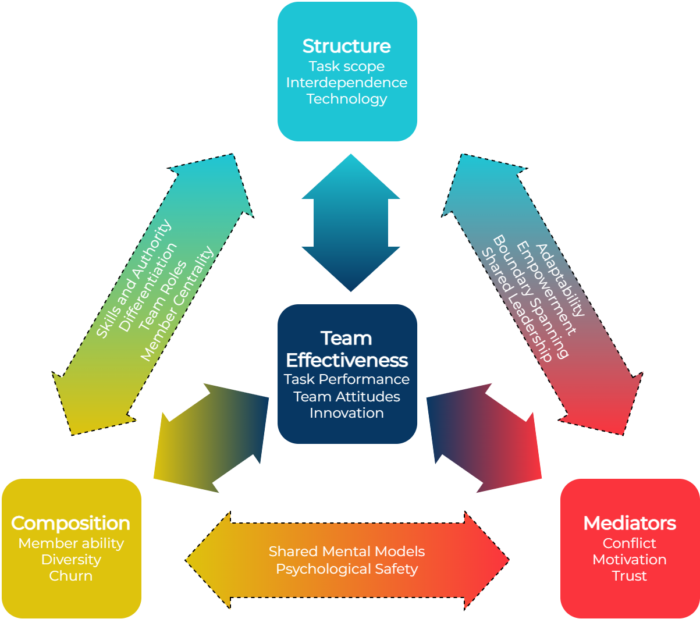One of the key building blocks of agile is the small team. Regardless of the agile framework being used, teams are where work is done. The effectiveness of teams is critical to the effectiveness of agile. Which begs the question, “What do we know about teams?”
The good news is we know a lot about teams: there is a wealth of knowledge about teams and team effectiveness built on decades of research and practice. This provides a comprehensive overview of what teams are and how to make them work. Before looking at the evidence, the first job is to define a team.
A team is two or more people in an organisation who interact socially, have one or more common goals, have different roles and responsibilities, and are interdependent on one another.
A Model of Teams
In a substantial review and meta-analysis by John Mathieu and his colleagues of recent research on teams including a meta-analysis of the evidence framed the research, using three types of features:
- Composition – features relating to the individuals in the team
- Structure – organisational features that affect the team, including task scope and team interdependence
- Mediators – social-psychological features that affect the impact of composition and structure on team outcomes.
These three types, and interactions between them, are inputs and mediating mechanisms that affect output: team effectiveness. Team effectiveness is defined in three ways:
- Task Performance – how well the team executes its tasks
- Team Attitudes – how the team feels about their work, their team, and their organisation
- Innovation – the team’s ability to create novel solutions to problems

What the data tells us
The model shows a wide range of different features of teams, painting a rich and complex picture. Studies of team effectiveness measure a set of team features and effectiveness dimensions; analysing this data shows which features affect team effectiveness as a correlation. The key results are shown in Table 1 below.
Table 1 Meta-analysis results for team effectiveness
| Measured Feature | Task Performance | Team Attitudes | Innovation |
|---|---|---|---|
| Support for Innovation | 0.58 | 0.47 | |
| Information Sharing | 0.41 | 0.41 | 0.39 |
| Empowerment | 0.51 | ||
| Task orientation | 0.45 | 0.42 | |
| Shared Leadership | 0.21 | 0.45 | |
| Boundary Spanning | 0.45 | 0.48 | |
| Team Size | 0.26 | 0.17 | |
| Team Longevity | -0.06 | 0.02 | |
| Team Efficacy | 0.41 | ||
| Intrateam Trust | 0.29 | 0.66 | |
| Process Conflict | -0.16 | -0.56 | 0.07 |
| Relationship Conflict | -0.14 | -0.52 | -0.09 |
| Psychological Safety | 0.29 | 0.57 | 0.15 |
| Vision | 0.49 |
Task Performance
The factors that impact task performance can be split into two groups. The first group are mediators. Support for innovation and the team’s beliefs in their own capabilities both improve task performance. Information sharing within the team is also significant but is shaped by conflict within a team. If conflict can be framed as a debate it enhances information sharing; conflict framed as disagreement is detrimental.
The second group are also mediators, but they interplay with structure: how the team fits in to the organisation. Of these, empowerment is the most significant. Beyond empowerment, task orientation and boundary spanning – working across the organisation and collaborating with other teams – improve task performance.
Team Attitudes
The biggest impact on team attitudes comes from intrateam trust. Trust mediates other relationships: it smooths over other sources of tension and helps create a positive team environment, including psychological safety. Using virtual teams was not found to reduce team effectiveness but trust was more important than when working face to face. Beyond trust, conflict in terms of both relationships (how team members get along) and process (how best to do the work) show large, negative impacts on attitudes, while self-managed teams improve team attitudes.
Most features that have the biggest impact on attitudes have a smaller impact on creativity and performance. The most important exception is internal team communication which has a similar and large impact across all aspects of effectiveness.
Innovation and creativity
The factors that drive innovation in teams are similar to those that affect task performance. The biggest impacts came from structural elements and team processes. Most are obvious: support for innovation, vision, task orientation, and internal team communication. The final major impact comes from external communication: communicating with other people as sources of ideas, knowledge, and other forms of information.
Other important findings
Some of the findings are not directly related to effectiveness but help us understand agile teams.
- Team size and longevity
The evidence shows that team size is a complex topic. A study from the Wharton School of Management showed that small teams perform better with complex tasks; other studies show little or no impact from team size. A meta-analysis of team innovation found that larger teams reduced individual innovation but increased team innovation. Similarly, keeping a team together for a long time can have both positive and negative impacts on performance, attitudes, and creativity – the overall picture is inconclusive.
- Team interventions
A small number of studies looked at actions to improve team effectiveness. Two stood out. Team preparation, such as team charters, improves team dynamics and performance. After-action reviews enhance team functioning and learning, improving subsequent performance.
- Measuring effectiveness
It is often difficult to get an external or objective measure of task performance or creativity, but where it is measured, it paints a different from self-report measures. Self-report measures, such as surveys, are more strongly related to team process factors and team attitudes; external measures (such as peer surveys) and objective measures (such as number of new products) tend to show an increased impact from structural features.
Lessons for Agile Leaders
Hundreds of studies of thousands of teams across a wide variety of work capture a lot of information: summarising that is challenging. To help summarise, we can focus on three core lessons for Agile leaders.
Agile works
Most of the core recommendations around Agile teams are supported by the evidence and validating agile practices. The data shows that Agile team practices all impact one or more dimensions of team effectiveness – with empowerment, self-managed teams, and both internal and external communication standing out. What is interesting is the comparatively lower impact of team composition – the size, roles, and diversity of the team. While all these factors have an impact on effectiveness, the effects are smaller than other structural factors and mediators. The evidence also supports agile practices as team interventions, specifically team charters and retrospectives (after action reviews) shown to be particularly effective.
Three faces of effectiveness
The second lesson from the research is the split of effectiveness into three main areas: task performance, team attitudes, and innovation. The evidence shows that the factors that improve performance and innovation are different from the factors that improve attitudes. This is an important lesson for agile leaders and coaches working to get the best from their teams by understanding which aspects of effectiveness need to be improved and selecting interventions that look towards the right face of effectiveness.
How you measure effectiveness determines what you see. Self-reporting measures are better suited to understanding team attitudes; objective measures give a clearer picture of task performance and creativity. Self-reporting is common and relatively easy but risks skewing the picture away from creativity and performance towards team attitudes. Creating robust and reliable objective measures is difficult, but a worthwhile investment to make agile work.
The team and the organisation
Perhaps the most important finding for creating high-performing agile teams is the impact of structural elements. The biggest drivers of performance and innovation come from the organisation rather than from within the team. The evidence tells us that to create a high-performing team you need to:
- Empower your teams
- Create a climate that supports and rewards innovation
- Have a clear vision, allowing the team to focus on their work
- Avoid silos and encourage inter-team communication and collaboration
These are actions of management and leadership. That is a good place to wrap up this post: if you want agile to work, if you want high-performing teams, the key is to create the space for the teams, given them a vision, support them, and let them get on with performing.
References
Hülsheger, U. R., Anderson, N., & Salgado, J. F. (2009). Team-level predictors of innovation at work: A comprehensive meta-analysis spanning three decades of research. Journal of Applied Psychology, 94(5), 1128–1145. https://doi.org/10.1037/a0015978
Kozlowski, S. W. J., & Bell, B. S. (2013). Work groups and teams in organizations. In N. W. Schmitt, S. Highhouse, & I. B. Weiner (Eds.), Handbook of psychology: Industrial and organizational psychology (pp. 412–469). John Wiley & Sons, Inc.. https://psycnet.apa.org/record/2012-28468-017
Mathieu, John E., Gallagher Peter T., Domingo Monique A., and Klock, Elizabeth A. (2019) “Embracing Complexity: Reviewing the Past Decade of Team Effectiveness Research” Annual Review of Organizational Psychology and Organizational Behavior 2019 6:1, 17-46 https://doi.org/10.1146/annurev-orgpsych-012218-015106

